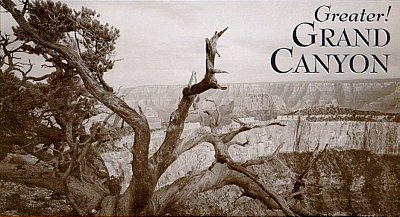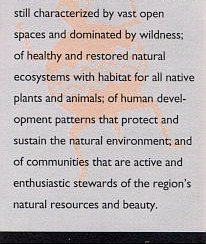
Summer 1998
|
The following article is an excerpt taken from the Summer 1998 issue of the Colorado Plateau Advocate,
a publication of the GRAND CANYON TRUST.

About the Grand Canyon there can be no question - it is one of the world's seven wonders by anyone's definition. Each year, millions of people journey great distances to enjoy spectacular views of multicolored cliffs, buttes and alcoves shaped by the relentless forces of wind and water.
While at first glance its vast and rugged landscapes may seem impervious to human impacts, the Greater Grand Canyon has in fact been compromised by sustained human demands on its natural resources.
We see several important threats affecting conservation in this region:
- Explosive population growth,
- Tremendous new pressure on land and water, leading to habitat fragmentation and groundwater depletion,
- Accumulated environmental problems from grazing, forest management, dam building, and other past management practices,
- Booming tourism and a recreation-dependent economy,
- Lack of conservation consciousness.
These forces translate to tangible, degrading effects on the environment - for instance, there are 98 officially listed threatened, endangered and sensitive species in the Greater Grand Canyon.
 The Grand Canyon Trust is engaged in a suite of activities in the Greater Grand Canyon region that are aimed at reducing and counteracting the ecological impacts of these threats. The Trust's community-based approach to conservation has led to significant successes and continued work in the Greater Grand Canyon:
The Grand Canyon Trust is engaged in a suite of activities in the Greater Grand Canyon region that are aimed at reducing and counteracting the ecological impacts of these threats. The Trust's community-based approach to conservation has led to significant successes and continued work in the Greater Grand Canyon:

- Reducing Grand Canyon Air Pollution - The Trust negotiated an agreement with the Environmental Protection Agency (EPA) and Navajo Generating Station to cut air pollution in Grand Canyon. Sulfur dioxide emissions were cut 90%. We are currently working to clean up the Mohave Power Plant in Laughlin, Nevada, the last "unscrubbed" power plant in the southwest.
- Restoring Ponderosa Pine Forests - The Trust is a founding partner in the Grand Canyon Forests Partnership, which will restore the ecological health and reduce the risk of catastrophic wildfire across 100,000 acres of northern Arizona's forests over the next 10 years. A primary goal of the Partnership is to help establish a local market for small forest products which will provide new jobs, diversify the local economy, and provide a revenue flow to support restoration projects.
- Creating a Model gateway Community - An environmentally responsible alternative is now available for dealing with the tremendous growth pressures at Grand Canyon National Park, thanks to the Trust's work with the U.S. Forest Service to develop Alternative H for the Tusayan Growth Environmental Impact Statement. Dubbed the "environmental alternative," this plan eliminates the use of groundwater for any new development, employs sustainable design features and maximizes energy, waste and water conservation methods.
- Greening Glen Canyon Dam - The Trust's work resulted in precedent-setting changes in operation of Glen Canyon Dam to protect the ecology of Grand Canyon and the Colorado River. We continue to be involved in the development and implementation of the Colorado River Management Plan.
Our successes and continued work in the Greater Grand Canyon reflect the Grand Canyon Trust's commitment to protecting and restoring the majesty of this diverse region, aligning ecology, economy and community for lasting conservation
- Geoff Barnard
|
Copyright © Bob Ribokas, 1994-1999, all rights reserved. This publication and its text and photos may not be copied for commercial use without the express written permission of Bob Ribokas.
|
|---|
|
|---|




 The Grand Canyon Trust is engaged in a suite of activities in the Greater Grand Canyon region that are aimed at reducing and counteracting the ecological impacts of these threats. The Trust's community-based approach to conservation has led to significant successes and continued work in the Greater Grand Canyon:
The Grand Canyon Trust is engaged in a suite of activities in the Greater Grand Canyon region that are aimed at reducing and counteracting the ecological impacts of these threats. The Trust's community-based approach to conservation has led to significant successes and continued work in the Greater Grand Canyon:
